Predation, parasitism, herbivory
I. The initial motivation for these types of studies arose from concerns
about managing populations of game species as well as controlling populations
of agricultural pests.
II. Predators catch individuals, consume them and remove them from the
prey population.
III. A parasite consumes a living host as well, but although it may increase
the host's probability of dying or reduce fecundity, a parasite does not
by itself remove an individual from the resource population.
IV. Herbivores eat whole plants or parts of plant. From the standpoint
of consumer-resource relations, herbivore may function either as predators,
consuming whole plants, or as parasites, consuming living tissue but not
killing their victims.
V. We might expect to see a tight correlation between the prey population
and the number of predators. Effects of predators and prey populatiions
on each other are extremely varied and difficult to predict.
A. Effects of predators on prey
1. Detrimental effects. Two examples from field of biological control,
a field of study which seeks to find long-term solutions to problems with
agricultural pests by finding natural enemies of these pests and using
predators or competitors to help keep the pest number down..
a. A ladybird beetle was released in CA to control cottony-cushion scale--an
important pest on citrus--and the beetle virtually wiped out its prey.
b. Klamath weed is a European plant that was introduced in CA in the
early 1900's. It thrived and by 1944 it covered about 2 million acres of
rangeland. In 1944 a Chrysolina beetle that ate Klamath weed was released
in Northern California and within 10 years it had reduced Klamath weed
population by 99%. These two examples show how effective predators can
be and are examples of an applied field called biological control. Biological
control
2. Although predator effectiveness is not surprising, there are many
counter examples. A species of weevil was released in New Zealand to control
Gorse bushes. This weevil has become of the most abundant insects in NZ
and eats about 95% of the seeds produced by the gorse bushes, but there
has been no effect on the overall abundance or distribution of the plant.
3. Two examples also illustrate very different effects of predation
on game populations.
a. Predators were removed from Cultus Lake in BC in an attempt to increase
the production of Sockeye salmon and successfully increased the percent
of young that returned as adults.
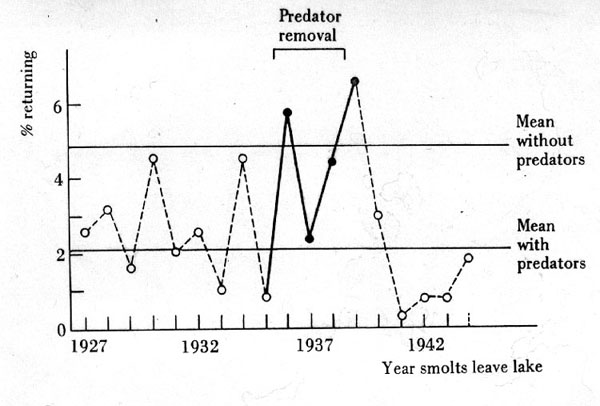
b. In contrast, in NY State, attempts were made to increase the number
of Ruffed Grouse, a popular game bird, by removing predators. Removal of
predators did increase nesting success but there was no increase in the
number of adults available for hunting in the fall.
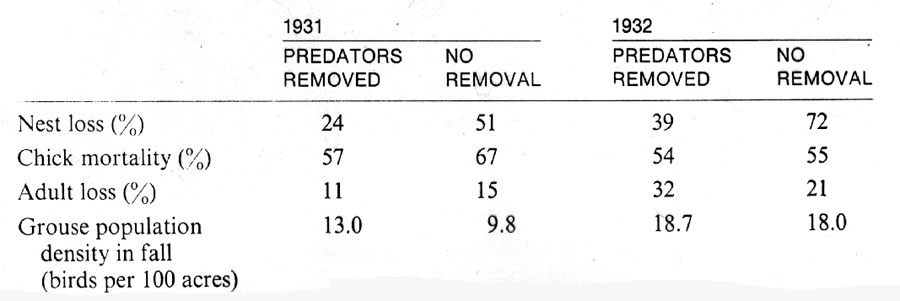
4. Very dramatic effects are observed when prey are exposed to new predators
with which their species has no history of interacting. A single snake
species the brown tree snake (Boiga irregularis), has been accidentally
introduced to several Pacific Islands, including Guam where snakes did
not naturally occur and has resulted in extinctions in less than a decade.
In Guam, prior to its introduction in the 1940's, there were 18 abundant
bird species. By 1980, there had been 7 extinctions and 4 are critically
endangered.
B. The effect that prey populations will have on the populations of
predators is also difficult to predict.
1. Ex. Moth larvae on a flowering ragwort plant, the number of moths
is determined largely by the number of flowering plants in the previous
year.
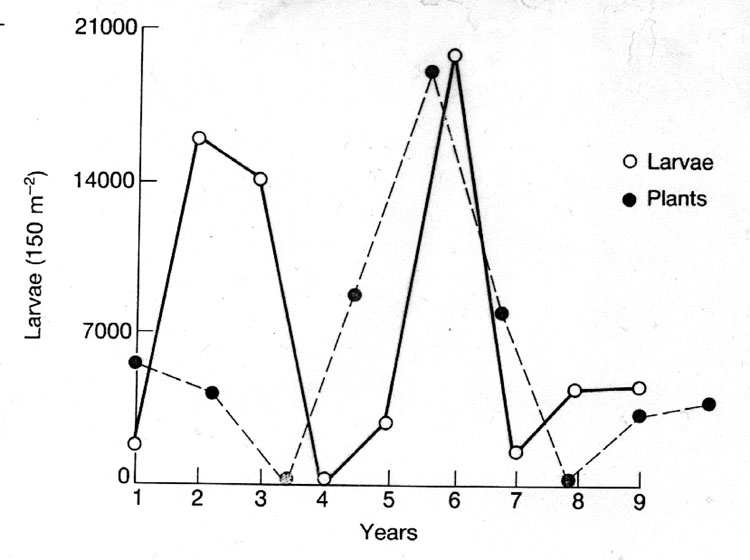
2. Wood mice and bank voles are prey for Tawny owls in the UK. Owls
maintain a constancy of abundance despite fluctuations in the numbers of
their small prey.

VI. Modelling simple predator-prey interactions where the predator densities
affect prey densities and vice versa.
A. Prey population growth rate.
1. If a prey population is left with no predators, it will (at least
until it approaches carrying capacity) increase exponentially. This is
seen many times when a species is released into a new habitat where predators
are absent. So start with the exponential growth rate.
dN/dt = rN
2. Introduce a predator that will slow the growth rate.
dN/dt = rN - (ones that get eaten)
3. Factors that determine how many get eaten?
a. How frequently the predator and prey encouter each other which is
a function of the population size of predators (P) and the population size
of prey (H).
b. Predator efficiency at capture, p.
4. Equation for growth rate of prey population moderated by predation
is dH/dt = rH - pHP
B. Predator population growth rate.
1. When no prey around, we can describe the decline in the predator
population as mP, where the population declines exponentially at a mortality
rate of m.
2. When prey are present, the population of predators will change like:
dP/dt = number born - mp
3. Factors relating to predation that affect the number of predators
born.
a. The population of predators already present, P.
b. The population of prey, H.
c. Predator efficiency at capture, p.
d. How many prey items it takes to make a new predator, or how nutritious
the prey are, a.
4. So the predator population is expected to change as: dP/dt = apHP-mP
5. The Lotka Volterra predation model has two equations, one for prey
populations and one for predator populations. To understand dynamics, find
points when populations are in equilibrium (population growth rates of
zero).
a. For prey, dH/dt = 0 when rH=pHP or P=r/p
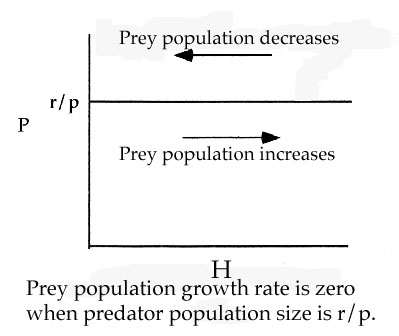
b. For predators, dP/dt=0 when apHP=mp or H=m/ap
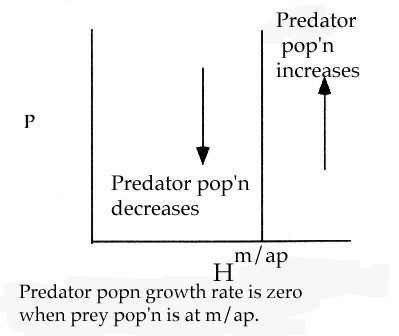
6. When these lines of equilibrium are combined. We see that the model
predicts cycling between prey and predators.

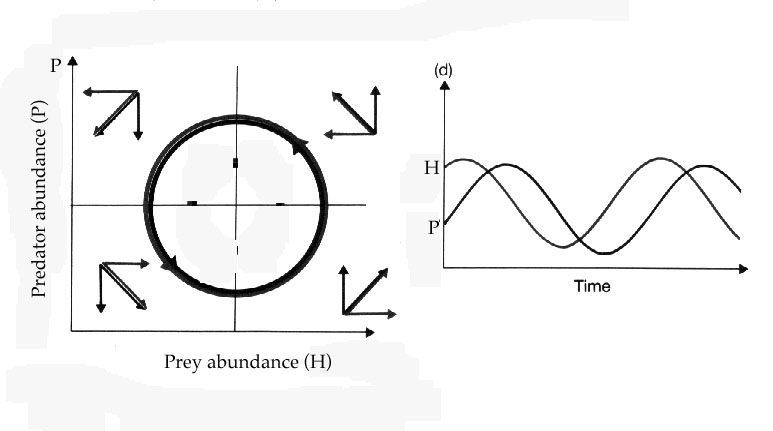
VII. Do predator-prey population cycles exist?
A. Laboratory work by Gausse on the protists Paramecium (prey)
and Didinium (predator) demonstrated that cycling occurred only
when the experiment was restocked with predators at regular intervals.
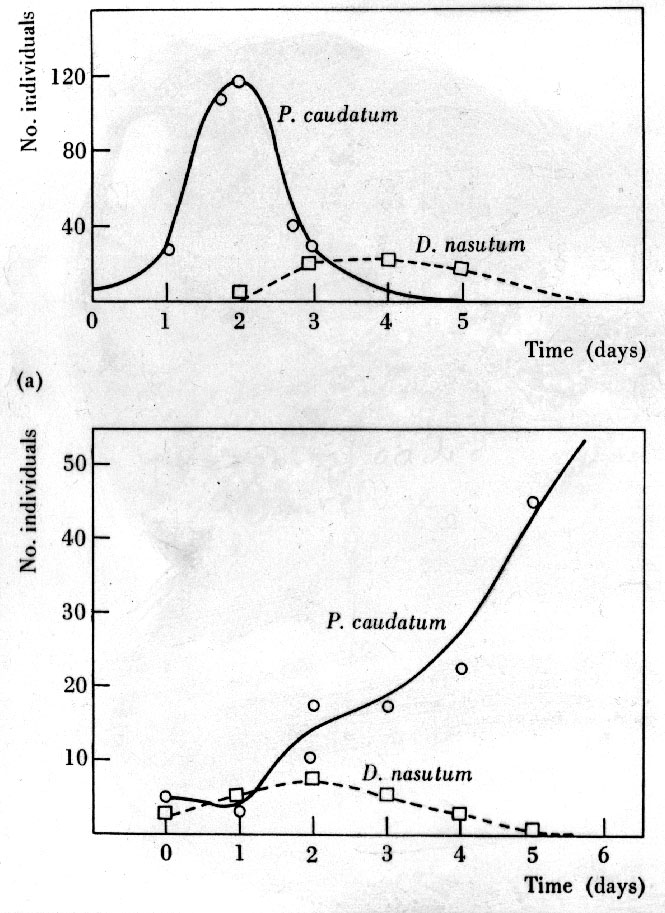
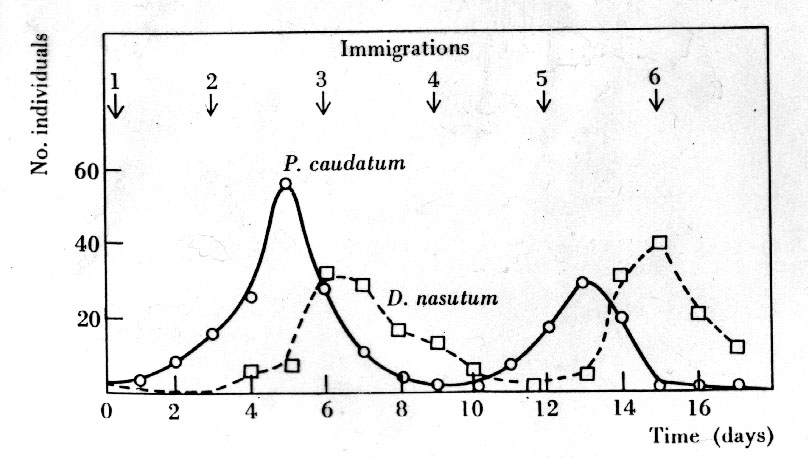
B. Snowshoe hare and lynx are a classic example in which 8-11 year cycles
have been observed for more than 80 years. But do predators determine abundances
and cycling of hare populations or is it the food supply of the hares?
Experiments demonstrate that both food and predators influence abundances.
Experiments removing predators or augmenting food did not eliminate cycling.
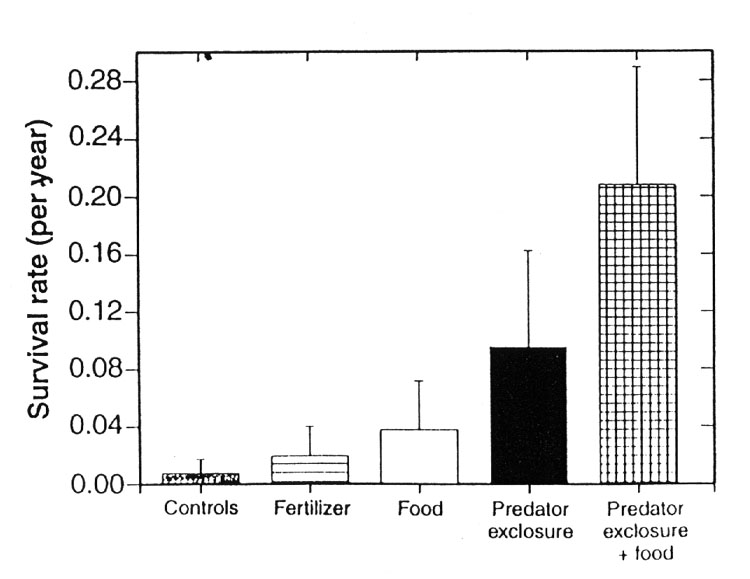
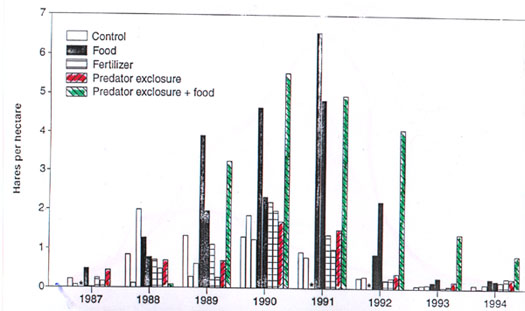
VIII. Mutualisms:--a relationship between two species that benefits both.
A. Complementary ways of obtaining energy and nutrients.
B. Defense in exchange for food and shelter.
C. Pollination and seed dispersal types of relationships.
D. These relationships may be facultative, meaning that the partners
can do with or without each other, or they may be obligate which means
that they are dependent on each other
E. Two examples of mutualistic relationships.Ants and acacia.
Yucca and yucca moth.
By the end of this lecture, you should understand
1) the variation in predator-prey interactions; 2) how simple predator-prey
interactions are modelled (i.e., if given equations, you should be able
to explain its terms and the dynamics it predicts); 3) how laboratory and
field experiments support or do not support the models discussed in class;
4) what mutualism is; 5) the general types of mutualism.











